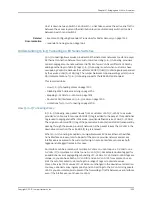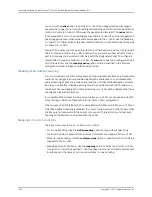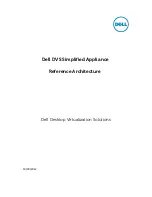
Understanding Proxy ARP on EX Series Switches
You can configure proxy Address Resolution Protocol (ARP) on your Juniper Networks
EX Series Ethernet Switch to enable the switch to respond to ARP queries for network
addresses by offering its own Ethernet media access control (MAC) address. With proxy
ARP enabled, the switch captures and routes traffic to the intended destination.
Proxy ARP is useful in situations where hosts are on different physical networks and you
do not want to use subnet masking. Because ARP broadcasts are not propagated between
hosts on different physical networks, hosts will not receive a response to their ARP request
if the destination is on a different subnet. Enabling the switch to act as an ARP proxy
allows the hosts to transparently communicate with each other through the switch. Proxy
ARP can help hosts on a subnet reach remote subnets without your having to configure
routing or a default gateway.
•
What Is ARP? on page 1301
•
Proxy ARP Overview on page 1301
•
Best Practices for Proxy ARP on EX Series Switches on page 1302
What Is ARP?
Ethernet LANs use ARP to map Ethernet MAC addresses to IP addresses. Each device
maintains a cache containing a mapping of MAC addresses to IP addresses. The switch
maintains this mapping in a cache that it consults when forwarding packets to network
devices. If the ARP cache does not contain an entry for the destination device, the host
(the DHCP client) broadcasts an ARP request for that device's address and stores the
response in the cache.
Proxy ARP Overview
When proxy ARP is enabled, if the switch receives an ARP request for which it has a route
to the target (destination) IP address, the switch responds by sending a proxy ARP reply
packet containing its own MAC address. The host that sent the ARP request then sends
its packets to the switch, which forwards them to the intended host.
NOTE:
For security reasons, the source address in an ARP request must be
on the same subnet as the interface on which the ARP request is received.
You can configure proxy ARP for each interface. You can also configure proxy ARP for a
VLAN by using a routed VLAN interface (RVI).
EX Series switches support two modes of proxy ARP, restricted and unrestricted. Both
modes require that the switch have an active route to the destination address of the ARP
request.
•
Restricted—The switch responds to ARP requests in which the physical networks of
the source and target are different and does not respond if the source and target IP
1301
Copyright © 2010, Juniper Networks, Inc.
Chapter 57: Bridging and VLANs—Overview
Summary of Contents for JUNOS OS 10.3 - SOFTWARE
Page 325: ...CHAPTER 17 Operational Mode Commands for System Setup 229 Copyright 2010 Juniper Networks Inc ...
Page 1323: ...CHAPTER 56 Operational Mode Commands for Interfaces 1227 Copyright 2010 Juniper Networks Inc ...
Page 2841: ...CHAPTER 86 Operational Commands for 802 1X 2745 Copyright 2010 Juniper Networks Inc ...
Page 3367: ...CHAPTER 113 Operational Mode Commands for CoS 3271 Copyright 2010 Juniper Networks Inc ...
Page 3435: ...CHAPTER 120 Operational Mode Commands for PoE 3339 Copyright 2010 Juniper Networks Inc ...
Page 3529: ...CHAPTER 126 Operational Mode Commands for MPLS 3433 Copyright 2010 Juniper Networks Inc ...
















































